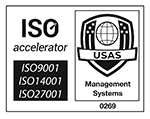Strengthening your organisation’s cyber defences.
The power of Multi-Factor Authentication and keeping software up-to-date.
As we celebrate Cyber Security Month 2023, it’s crucial to shed light on two vital pillars of defence – Multi-Factor Authentication (MFA) and keeping software up to date.
In the ever-evolving landscape of cyber security, where threats are becoming more sophisticated by the day, UK small and medium-sized business owners and senior leaders face a monumental challenge: protecting their organisations from the increasing threats from cyber criminals.
SME owners and senior leaders must stay vigilant in protecting their organisations from their tactics. In this blog, we will delve into two essential strategies that can bolster your organisation’s defences: Multi-Factor Authentication (MFA) and regular software updates.
The cyber security battleground
In today’s digital age, where information is currency, organisations of all sizes are prime targets for cyber criminals. The consequences of a successful cyber attack can be catastrophic, ranging from data breaches and financial losses to damage to an organisation’s reputation. As the saying goes, it’s not a matter of “if” but “when” a cyber attack will occur. Therefore, proactive measures are essential.
Multi-Factor Authentication: Your first line of defence
One way to enhance your organisation’s resilience is by implementing Multi-Factor Authentication (MFA). MFA provides an additional layer of protection – beyond a username and password – significantly reducing the risk of someone gaining unauthorised access. By activating multiple authentication factors for all your users, such as a fingerprint scan or a unique verification code, MFA ensures that only authorised users can access sensitive information and systems.
Why is MFA essential in the fight against cyber criminals?
It eliminates the single point of failure that traditional username and password combinations often present. Even if a cyber criminal obtains login credentials, they cannot gain access without the additional authentication. MFA serves as a barrier that cyber criminals find challenging to overcome, providing peace of mind and protecting your business from data breaches and unauthorised access.
Steps to implement MFA
Implementing MFA doesn’t have to be challenging. Identify the systems and applications that contain critical data and sensitive information. Collaborate with your IT partner to determine the most suitable MFA solution. Once chosen, communicate the importance of MFA to your employees and provide clear instructions on how to set it up. Your trusted IT partner can help you with the implementation process, ensuring a seamless transition and comprehensive training for your team. Remember, your IT partner is here to support you, so don’t hesitate to ask for advice and guidance.
The elements of MFA
Imagine a fortress with multiple layers of security: moat, drawbridge, and sturdy walls.
MFA functions similarly by adding layers of authentication before granting access to sensitive systems and data. It goes beyond the traditional username and password approach.
1. Something you know: This is your password.
2. Something you have: This could be a smartphone or a token.
3. Something you are: Biometric data like fingerprint or facial recognition.
By requiring at least two factors, MFA makes it exponentially more challenging for cyber criminals to breach your systems. Even if they can obtain your password they won’t have the other required elements.
“Ransomware is fundamentally about criminal monetisation of cyber vulnerabilities. The most effective systemic response is preventing future attacks by investing in increased resilience and better-protected systems.”
James Babbage, National Crime Agency Director General Threats
Ransomware, extortion and the cyber crime ecosystem white paper
The importance of software updates
When it comes to defending your organisation against cyber threats, regularly updating your software is paramount. Software updates, often accompanied by patches and security fixes, address vulnerabilities that cyber criminals could exploit. Failing to update your software leaves your systems susceptible to attacks and compromises any security in place.
Why are software updates crucial in the battle against cyber crime?
Cyber criminals are constantly evolving their tactics to exploit vulnerabilities. Software developers respond by releasing updates that address these vulnerabilities and keep their systems secure. By promptly applying software updates, you equip your organisation with the latest security measures and ensure potential entry points for cyber attacks are mitigated.
Steps to stay up-to-date
Keeping your organisation’s software up-to-date doesn’t have to be a daunting task. Start by implementing a robust patch management process that regularly checks for available updates and ensures timely installations. Collaborate with your IT partner to establish a proactive software update strategy for your organisation’s technology. Your IT partner can assist in automating the update process, minimising downtime and maximising security. By working hand in hand with your IT partner and utilising their expertise, you can stay one step ahead of cyber criminals and protect your people, customers and data.
The importance of software updates
Software is the backbone of modern businesses. Whether it’s your operating system, productivity tools, or security software, keeping everything up to date is paramount. Here’s why:
1. Patch vulnerabilities: Cyber criminals exploit weaknesses in software. Updates often include security patches that fix these vulnerabilities, preventing potential breaches.
2. Stay compliant: In many industries, compliance with data protection regulations is mandatory. Regular software updates help you maintain compliance.
3. Enhanced features: Updates aren’t just about security; they often bring improved functionality and features, boosting productivity and efficiency.
Collaborating with your IT partner
The technological landscape can be hard to navigate for businesses with small to no internal IT teams, so partnering with a reliable IT partner easily enhances your IT capability and expertise. Your IT partner serves as a trusted advisor, guiding you through the world of cyber security and providing the expertise needed to fortify your organisation’s defences. They have firsthand knowledge of the latest cyber threats, industry best practices, and cutting-edge technologies. By harnessing their insights, you can gain a competitive edge in the battle against cyber crime while focusing on your core business objectives.
For small to medium-sized organisations the complexities of cyber security can be daunting. A trusted IT partner like IT Champion is your best avenue for expert advice, guidance and help.
Here’s why it’s paramount:
1. Expertise: IT partners have the knowledge and expertise to implement MFA and manage software updates seamlessly.
2. Focused solutions: They can provide solutions that are specifically calibrated to meet your organisation’s individual needs and budget.
3. 24/7 monitoring: IT partners offer round-the-clock monitoring to detect and respond to threats.
Protecting your organisation from cyber threats requires a proactive and comprehensive approach. Integrating MFA as an additional layer of protection and staying on top of software updates are two crucial steps to bolster resilience and reduce risks. Partnering with a reliable IT provider empowers you with the knowledge and resources needed to stay ahead of cyber criminals. By embracing these practices, you safeguard not only your organisation’s sensitive information but also corporate integrity and brand reputation. Take action today and build strong defences that withstand the ever-evolving cyber landscape.
This Cyber Security Month, take action to strengthen your organisation’s defences. Implement MFA, keep your software updated, and forge a partnership with your IT champion to secure a safer digital future for your business.






